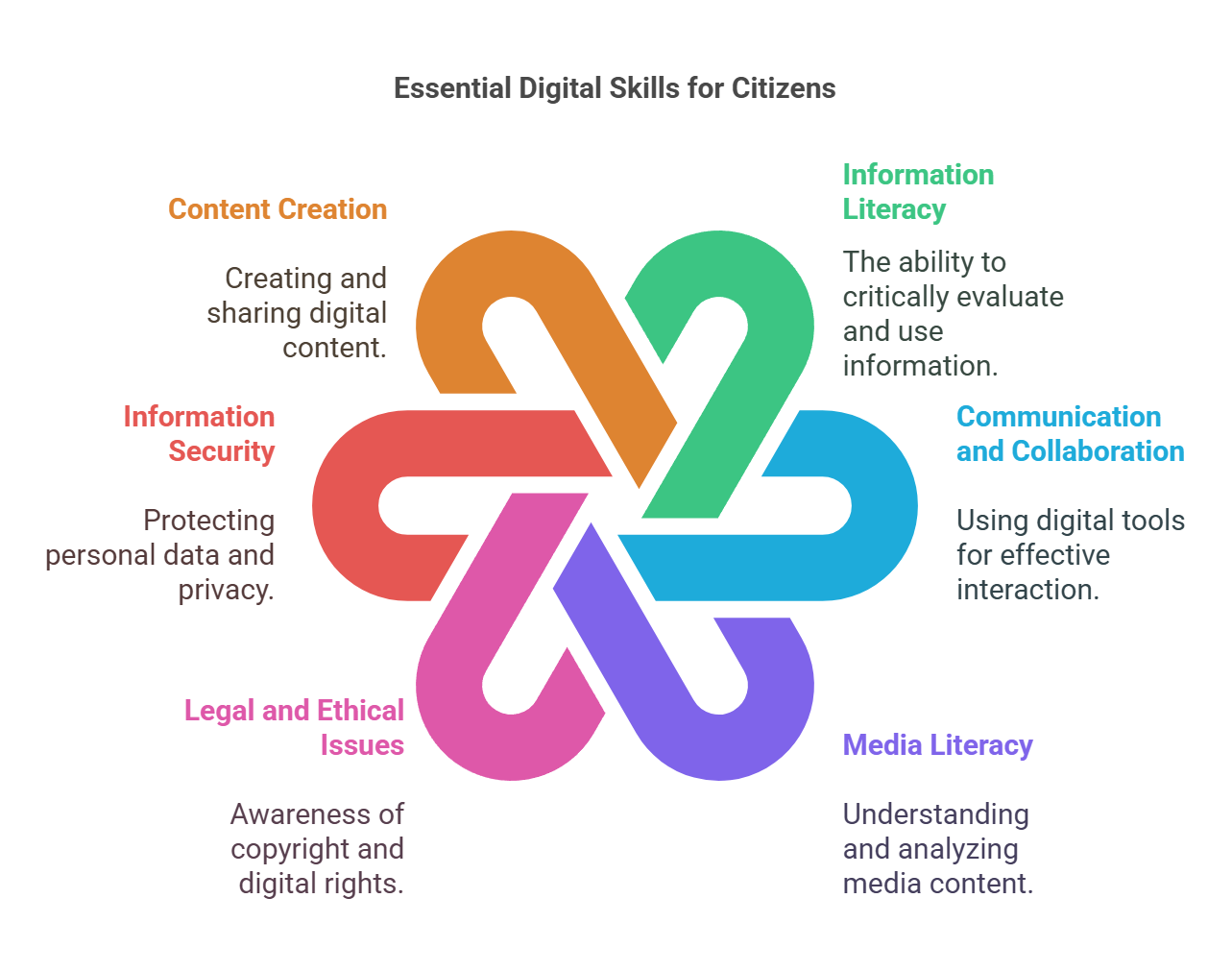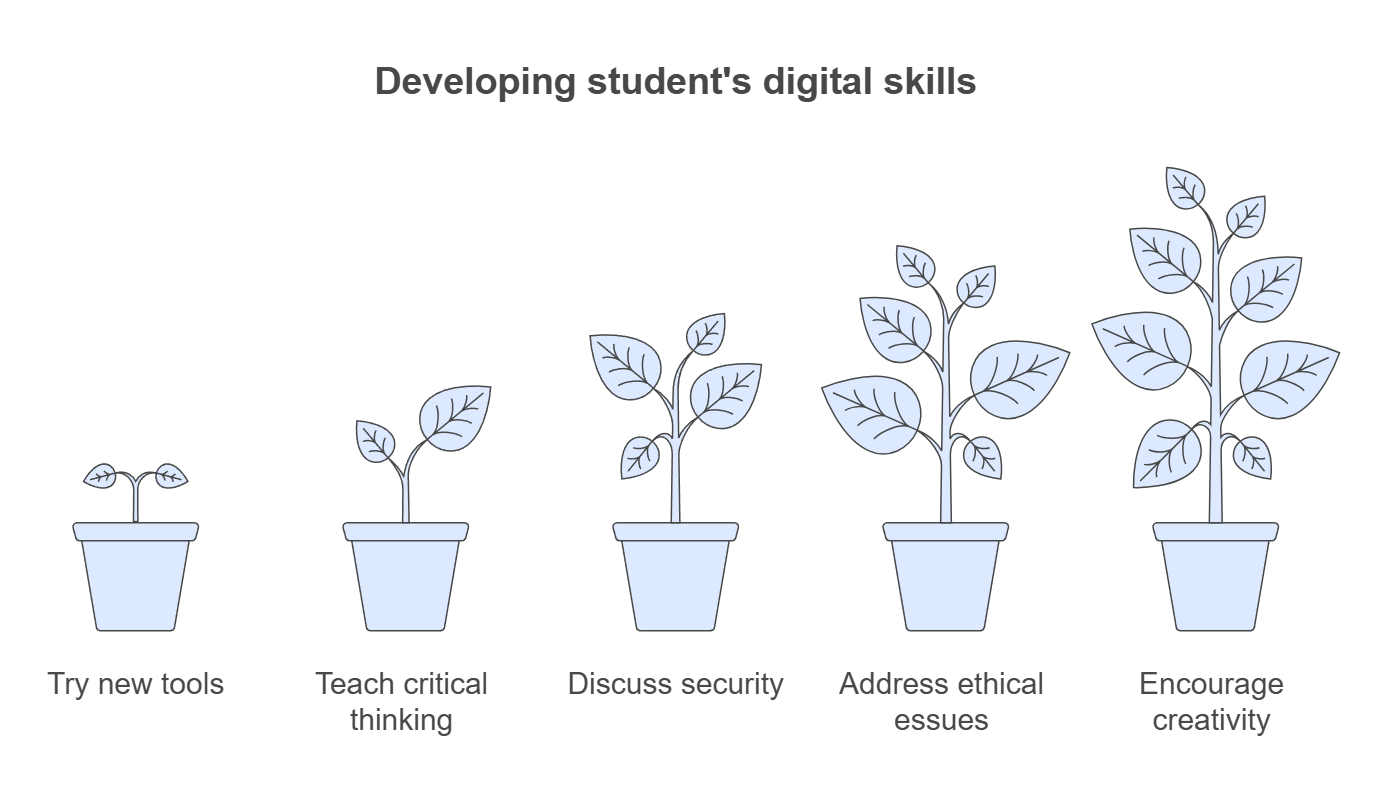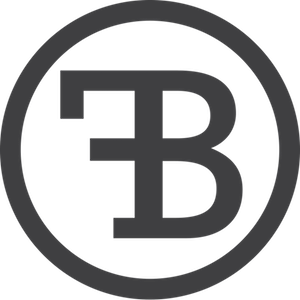Digitalisation has become part of our everyday lives, and its impact extends to education. So, what are these digital skills?
Digital literacy is not limited to the use of a computer or smartphone, but can include the following areas:

Made with Napkin
The European Digital Competence DigComp 2.2.[i] Framework provides concrete examples of the knowledge, skills and attitudes citizens need to assess digital content:
Knowledge
- Be aware that online environments contain all types of information and content including misinformation and disinformation.
- Know the importance of identifying who is behind information found on the Internet (e.g. on social media) and verifying it by checking multiple sources.
Skills
- Know how to differentiate sponsored content from other content online.
- Know how to analyse and critically evaluate search results and social media activity streams, to identify their origins, to distinguish fact-reporting from opinion, and to determine whether outputs are truthful or have other limitations.
- Know how to find the author or the source of the information, to verify whether it is credible.
Attitudes
- Willing to fact-check a piece of information and assess its accuracy, reliability and authority, while preferring primary sources over secondary sources of information where possible.
Citizens’ resilience against information interference
Over the past two years, the debate has increasingly focused on information and electoral influence via the Internet and on strengthening citizens’ resilience.
The 2024 edition of the World Economic Forum’s Global Risk Report[ii] concludes that disinformation is the most serious threat in the short term (2 years), and the fifth most serious threat in the longer term (10 years). According to the report, disinformation can radically disrupt electoral processes and cause civil unrest and clashes. It also leads to growing distrust of the media and government sources. It also deepens polarised views even in established societies.
There are many cautionary examples of such behaviour, the most recent and serious being Romania, which on 6 December 2024 became the first EU country to cancel elections due to foreign interference following reports of data manipulation on TikTok.[iii]
Disinformation can disrupt electoral processes and cause unrest and polarisation.
Disinformation spreads almost unhindered on social media platforms, even when borders are closed. Finland is not immune to the threat of disinformation.
An editorial in Finnish newspaper Ilta-Sanomat (4.8.2024)[iv] sums up perfectly what should be done: “In addition to reliable media, fighting disinformation requires, among other things, state preparedness for the threat – and good media literacy education. At the forefront of the fight are vigilant citizens who are able to recognise attempts to influence them and do not get provoked when provoked.”
But resilience does not happen by itself, and knowledge and skills need to be diligently updated, especially as AI technology develops. More is needed, such as:
- Regulating platforms and monitoring and communicating regulations (e.g. EU digital and AI regulations are a good starting point);
- Research;
- Fighting against disinformation and cooperating internationally (e.g. Faktabaari[v], NORDIS[vi], EDMO[vii]);
- Reliable journalism and media self-regulation (e.g. Council for mass media in Finland[viii]);
- Digital and AI education (in schools, libraries, workplaces, military, adult education, etc.).
Digitalisation is not just about technical infrastructure, technology, applications, devices or network connections.
Digital information literacy
Digital literacy is therefore not just about technical infrastructure, technology, applications, devices or network connections. Faktabaari – in partnership with teachers – has chosen the following key area of action to promote:
- Young people’s ability to critically evaluate online content and generative AI outputs;
- Understanding of the impact of algorithms on search results and recommendations;
- An awareness that our data constantly being collected and used for informational purposes;
- The ability to manage our privacy and digital security in the digital environment.
Faktabaari presented a definition of digital information literacy in the DIL Guide[ix]. It has since been expanded to include AI literacy as part of digital literacy:
Digital information literacy is the ability to access, manage, understand, integrate, communicate, evaluate, create, and disseminate information safely and appropriately through digital technologies.
It includes information and media literacy, as well as artificial intelligence and data literacy, which helps understanding of the digital information world in a broader sense.
Digital information literacy involves a dimension of active and civic engagement with the digital world and promotes active citizenship.
The guide also presented the Finnish curriculum’s definitions of multiple literacies and international literacies, as well as various online literacy skills and strategies.
Over the past two years, the online reflection on the three questions below has proved to be very useful.
When faced with unfamiliar online content, it is always a good idea to find the answers to three simple key questions before spending time exploring the content in more detail:
- Who is behind the information? (source)
- What is the basis for this claim? Evidence?
- What do other sources say?
Teaching techniques[x] of online reflection have been shown to be an effective way to promote digital source criticism and lateral reading skills among citizens[xi]. Lateral reading refers to the process of checking the background of online information (reliability of the author, facts, statistics, sources, etc.) from different sites and sources before delving into the text at hand.
Faktabaari has published[xii] educational videos and teaching materials to support teachers. For example: Recommendation algorithms; Check 3 questions; Identify error; Lie & gossip; Try reverse image search; Lateral reading; etc.
According to the recommendations of the Finnish Critical Research project[xiii], every young person needs critical literacy skills, i.e. the ability to search for information in different media, assess the reliability of texts and compare the information they contain. According to the study, critical literacy and basic reading skills should be supported in parallel and reading challenges should be addressed as early as possible. They have also produced tools for teaching critical online literacy[xiv].
The Finnish framework for digital competence
The Finnish Ministry of Education published the “Digital competence in early childhood education and care, pre-primary education and basic education” frame[xv] in 2022, just before the global roll-out of generative AI.
The framework descriptors clarify with concrete examples how digital competency can be built up from early education to the end of comprehensive basic education. The aim is for education providers to update their digital strategies and plans and their curricula in line with the proposed new digital framework.
Digital competence and ICT competence as a whole consists of four main areas:
1. Practical skills and personal production
2. Security and responsibility
3. Information management and inquiry-based and creative work
4. Interaction
Concrete and illustrative descriptions encourage teachers to use digital environments in a variety of teaching activities. Digital environment refers to all digital solutions, services, devices and tools used in education and early childhood education – and more recently also AI services. The competency descriptions give an indication of what digital skills should be taught at which level. New technologies enable learners of all ages to play not only passive social media roles, but also active roles as actors, producers and researchers.
The teaching of digital skills will ultimately fall to teachers at all levels and in all subjects. It is therefore essential that education and early childhood education providers are responsible for ensuring that the equipment and services available to teachers comply with the EU Data Protection Regulation and national legislation. In addition, teachers should receive systematic in-service training and clear guidance on how to work safely and responsibly in digital learning environments.
PISA, digitalisation and mobile phone bans
According to PISA 2022[xvi], 15-year-olds’ maths, science and literacy skills declined in most OECD countries, including Finland.
The reasons for the decline in results have been the subject of a wide range of speculation[xvii]. Possible reasons for the drop in results have been put forward in the public debate, including digitalisation, pupils with an immigrant background, pandemics, phenomenological learning, inclusion and self-direction.
The PISA study provides a rather limited view on the link between the use of digital devices and learning outcomes. Pupils have experienced the use of devices as somewhat disruptive to learning, but on the other hand, moderate use of digital resources seems to have a positive link to learning outcomes[xviii].
The debate on the use of mobile phones by children and young people has been heated, and their use in lessons has been and will be further restricted.
However, restricting the use of mobile phones does not mean that schools should not give all children and young people the opportunity to learn important digital skills, responsible use of the Internet and critical online literacy.
The debate should also consider whether Finnish teachers have sufficient basic knowledge to use digital environments and AI applications effectively to support teaching, and how to organise and fund the necessary systematic digital teacher training.
New technologies also enable learners to play an active role as actors, producers and researchers.
How can you develop your digital skills?
Learning digital skills, for example by testing and playing with different AI services, can open a new way of doing everyday tasks. For example, AI can be a fun way to make travel or holiday plans, effortlessly translate text from one language to another, and create great pictures and videos. They are powerful tools for planning lessons, selecting materials and brainstorming. Teachers can use their digital skills to inspire students to use their personal smart devices for more than just browsing and playing on social media.
Teachers have a key role to play in developing their students’ digital skills. Digital skills are essential in the world of work and help students participate in social debate. New technologies can make learning more engaging and interactive.
AI literacy
AI is a key emerging digital skill. It refers to an understanding of how AI works, its principles, concepts and applications, as well as an awareness of the limitations, implications and ethical considerations of using AI.
Currently, the most recent and comprehensive definition of AI literacy is based on the definition presented by Bozkurt in autumn 2024[xix]:
AI literacy is the comprehensive set of competencies, skills, and fluency required to understand, apply, and critically evaluate AI technologies, involving a flexible approach that includes foundational knowledge (Know What), practical skills for effective real-world applications (Know How), and a deep understanding of the ethical and societal implications (Know Why), enabling individuals to engage with AI technologies in a responsible, informed, ethical, and impactful manner.
AI literacy equips teachers and learners to be informed users of AI and experts in AI technologies. Essentially, it also includes an awareness of how to modify teaching and assignments to enable learners to exploit the potential of AI as a tool for learning and critical thinking.

Made with Napkin
Some practical tips for developing students’ digital skills
- Try new tools: be curious and experiment with different applications and software in your classroom. This may also inspire your students.
- Teach critical thinking: encourage students to critically evaluate the information they see. Encourage students to encourage their peers to analyse and evaluate the information they see. Discussions about where the information comes from will help them to understand the reliability of the information.
- Talk about security: teach students how to protect their information online. This is an important part of digital well-being.
- Discuss ethics: raise copyright and other legal issues to help students understand the importance of responsible behaviour.
- Encourage creativity: let students create their own digital projects. Encourage pupils to create their own projects.
Read the entire AI Guide for Teachers here.
Sources
[i] DigComp 2.2. (2012) JRC https://publications.jrc.ec.europa.eu/repository/handle/JRC128415
[ii] Global Risks 2024: Disinformation tops global risks (2024) World Economic Forum https://www.weforum.org/press/2024/01/global-risks-report-2024-press-release/
[iii] European Parliament Think Thank (haettu 12.12.2024) Mis- and disinformation on social media and related risks to election integrity https://www.europarl.europa.eu/thinktank/en/document/EPRS_ATA(2024)767150
[iv] Pääkirjoitus: Britannian mellakat ovat varoittava esimerkki sosiaalisessa mediassa levitettyjen valheiden vaikutuksista. (4.8.2024) Iltasanomat https://www.is.fi/paakirjoitus/art-2000010607694.html
[v] Faktabaari – www.faktabaari.fi
[vi] Nordic Observatory for Digital Media and Information disorder NORDIS (read 12.12.2024) https://www.nordishub.eu/
[vii] European Digital Media Observatory EDMO (read 12.12.2024) https://edmo.eu/
[viii] JSN https://jsn.fi/en/journalists-guidelines/
[ix] Digital Information Literacy Guide (2022) Faktabaari. www.faktabaari.fi/dil
[x] Online reading skills and strategies (2022) Digital Information Literacy Guide, Faktabaari. https://faktabaari.fi/edu/6-online-reading-skills-strategies/
[xi] Osborne, J., Pimentel, D., Alberts, B., Allchin, D., Barzilai, S., Bergstrom,C., Coffey, J., Donovan, B., Kivinen, K., Kozyreva. A., & Wineburg, S.(2022). Science Education in an Age of Misinformation. Stanford University, https://sciedandmisinfo.stanford.edu/
[xii] Faktabaari www.faktabaari.fi/dil
[xiii] Critical selected articles https://educritical.fi/fi/tuotokset/selected-articles/#pll_switcher
[xiv] Critical https://educritical.fi/en/
[xv] The Framework for Digital Competence https://eperusteet.opintopolku.fi/#/en/digiosaaminen/8706410/osaamiskokonaisuus/8706431
[xvi][xvi] PISA 2022 (2022) Valtioneuvosto. Ensituloksia lyhyesti https://julkaisut.valtioneuvosto.fi/bitstream/handle/10024/165296/Pisa22%20ensituloksia%20lyhyesti.pdf?sequence=1&isAllowed=y
[xvii] Juhani Rautopuro (2024). Mitä Pisa mittaa – ja mitä se ei todellakaan mittaa. Kieliverkosto. https://www.kieliverkosto.fi/fi/journals/kieli-koulutus-ja-yhteiskunta-maaliskuu-2024/mita-pisa-mittaa-mita-pisa-ei-todellakaan-mittaa?fbclid=IwAR25limMgSGl1aEPKlPuu-UvP2rzZfbzo33iDBXBTfwTA8vdQ-1961LJec8
[xviii] Hiltunen, Jenna; Ahonen, Arto; Hienonen, Ninja; Kauppinen, Heli; Kotila, Jenni; Lehtola, Piia; Leino, Kaisa; Lintuvuori, Meri; Nissinen, Kari; Puhakka, Eija; Sirén, Marjo; Vainikainen, Mari-Pauliina; Vettenranta, Jouni. 2024. PISA 2022 ensituloksia. Opetus- ja kulttuuriministeriön julkaisuja 2023:49. https://julkaisut.valtioneuvosto.fi/handle/10024/165295
[xix] Bozkurt, A. (2024) ‘Why Generative AI Literacy, Why Now and Why it Matters in the Educational Landscape? Kings, Queens and GenAI Dragons’, Open Praxis, 16(3), p. 283–290. Available at: https://doi.org/10.55982/openpraxis.16.3.739
Read the entire AI Guide for Teachers here.

